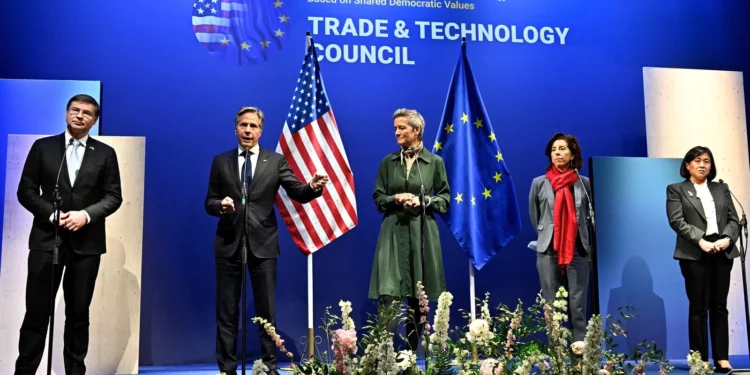Here’s what to know about the EU-US Trade and Technology Council
US Secretary of State Antony Blinken and European Commission Executive VP Valdis Dombrovskis were among the US and EU Trade and Technology Council (TTC) officials who gathered in Belgium for a two-day summit to discuss a cross-Atlantic trade and technology agreement.
The summit was the last council gathering before both the European Parliament elections in June and the US presidential elections in November.
The agenda at the 6th meeting of the TTC centred on building closer cooperation on advanced technologies, such as 6G mobile telecommunications, AI and the solar PV energy value chain.
What is the TTC?
The TTC was established in 2021 as a platform for cooperation between the EU and US, with several key aims, including: growing bilateral trade and investment; avoiding unnecessary technical barriers to trade; and coordinating to seek common ground and strengthen global cooperation on technology, digital issues and supply chains.
Part of the council’s mandate is to promote and protect shared values and trade interests, and to find common ground to resolve global trade challenges, such as navigating the COVID-19 pandemic and geopolitical instability like Russia’s invasion of Ukraine.
Cooperation between the EU and US helps shape future dialogue and response to key trade and technology related issues, threats and developments.

The US was the EU bloc’s largest export market for goods in 2023.Image: Eurostat
Almost one-fifth of the EU’s exports of goods went to the US in 2023, making America the bloc’s largest export partner, says Eurostat. In the same year, the US was the second largest importer of goods into the EU, accounting for 13.7% of the bloc’s imports.
What is the TTC’s aim?
As well as safeguarding trade security by formulating a unified response to geopolitical events that impact global trade, the TTC plays a role in strengthening cross-Atlantic economic trade ties.
It is also responsible for accelerating the transition to climate-neutral economies. However, while a transatlantic initiative on sustainable trade (TIST) was previously established by the TTC, the high hopes surrounding it have not translated into policy outcomes.
Moving forward, this initiative and a continued focus on sustainability could help foster greater cooperation toward building green markets and dealing with border carbon adjustments.
The 6th TTC meeting attempted to shape dialogue and promote greater cooperation between the EU and US, to bolster diversity and supply chain resilience. At the meeting, new partnerships on artificial intelligence and 6G telecommunications networks were announced as well as extended cooperation efforts on semiconductor supply chains.

The January US-EU Trade and Technology Council Ministerial Meeting was held in WashingtonImage: REUTERS
This includes a commitment to deepen information-sharing on supply chains for older ‘legacy’ semiconductors, with a joint statement expressing concerns about unfair trade practices, such as government subsidies for Chinese chip manufacturers, distorting the global market.
Furthermore, US and EU surveys will be conducted to assess the impact of low-price legacy semiconductor imports on nation security and critical infrastructure.
What happens next?
A change in US leadership could result in new tariffs or other trade restrictions on exports from China and the EU into the US. This ‘elephant in the room’ is not lost on the TTC delegates meeting in Belgium for the last time before November’s US presidential election.
While the TTC has few major policy achievements to its credit, it is seen as an important vehicle to protect and promulgate the Western trade alliance and, in the words of one EU official: “the promotion of our common values and cooperation against countries like Russia and China, who apply different approaches to the trading system or their technological ambitions.”
Beyond the EU and US interests, the World Economic Forum’s Global Future Council on the Future of Trade and Investment brings together leaders from government, business and civil society to discuss critical issues, share insights and collaborate to help shape trade and investment agendas.









